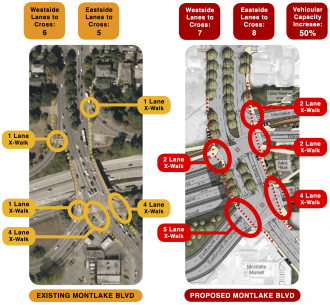
There are two interesting nuggets in this recent Cascade Bicycle Club campaign: 1. You should contact the Seattle Council and mayor to solidify their support for a resolution to support improved biking and walking in the 520 Bridge replacement project, and 2. WSDOT admitted at a Council briefing that biking and walking is not its strong suit (and then asked the city for help).
We have written several times before about the 520 Bridge. The biggest issue has been the lack of a biking and walking trail across the Portage Bay segment of the bridge, but there are plenty of issues of nearly equal importance in Montlake, which would see a significant decline in the biking and walking environment under current designs. The state has asked for city guidance on the Seattle side of the bridge, and Cascade has a handy tool you can use to let leaders know this is important to you.
But as Jay Inslee takes office, it’s clear that the state’s transportation department needs big changes. Buried in a series of last-century-style multi-billion-dollar highway expansion projects (despite declining driving rates), the department is having serious trouble maintaining existing roads under its control.
The country is changing the way it moves around, and Seattle and much of the state is leading the way. We need a transportation department that excels at the biking, walking and transit projects that will help inspire the future, not a department that continues to spend tons of money on projects that benefit the personal automobile at the expense of people on foot and on bike.
Transportation for Washington sent Inslee a plan yesterday aimed at doing just that: Shifting the state’s priorities to be a clear leader in sustainable, healthy and financially-sound transportation.
Below is Cascade’s call for action regarding the 520 Bridge:
The first steps to ending an addiction are coming clean, admitting you have a problem and asking for help. Last month, the Washington State Department of Transportation (WSDOT) took these first steps.
When asked at a City Council meeting how they would work to make the Seattle side of the SR 520 corridor safe for people of all ages and abilities to walk and bike, Julie Meredith, the SR 520 Program Director for WSDOT, explained that their main focus is moving cars and admitted when it comes to walking and bicycling, “We don’t excel at that.”
All you have to do is look at the dark, scary and dangerous trail under the Portage Bay Bridge to know WSDOT has a serious problem when it comes to making it safe for people to walk and bike.
But they did more than admit their problem; WSDOT asked the City of Seattle for help. Fortunately, the City of Seattle has the ability to help WSDOT get this project done right – but they need to hear from you today.
Thanks to “overwhelming support” from the community and nearly 800 people like you writing the City Council telling them to get SR 520 right, the Council is already working on a Resolution that will call for the City working with WSDOT to improve walking and biking connections in Montlake and build a shared use trail on the Portage Bay Bridge.
But there’s no guarantee that the Council will pass this Resolution. They need to hear loud and clear that everyone, from an 8-year old child to his 80-year old grandmother, should have the freedom to safely walk and bike in and through the Seattle side of the SR 520 corridor.
T4Washington’s plan:
Transpo4WA Opportunity for All Action Plan 2012-12-20 Reduced







